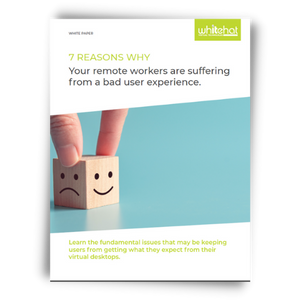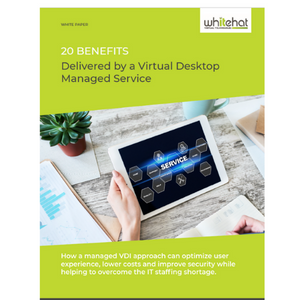“If IT spends more time supporting legacy IT than building IT capabilities the business needs, there is likely a lot of “technical debt” or a lack of understanding of how IT can productivity, growth and competitive advantage most notably at the C-Level.”
IT for its own sake is just dumb. Getting business value out of your IT is imperative if you want to prosper.
- 1. Every business buys IT. Every business has IT. However, not every business understands how to get value out of IT.
2. IS IT seen as either a necessary evil or as a bottomless pit that endlessly consumes company resources in your company?
3. This is a flawed perspective — and one often compounded by how daily IT Operations is actually managed. - 4. The reality is, IT can and must deliver tangible value.
5. Recognizing this truth is the first step to building a healthy IT environment that contributes to growth and doesn’t merely exist for its own sake.
Phase 1. IT Stabilization. Moving IT Operations from zero to stable, delivering a consistent IT environment. Achieving Phase 1 stability unlocks Phase 2.
Phase 2. Leverage. This is where transformation and business growth occurs.
The problem is that many are stuck in phase 1. And, frustratingly, being in this situation can contribute to the bad thinking that keeps them locked in Phase 1, only seeing IT as (at best) a necessary evil.

Here are six reasons organizations end up stuck in Phase 1 unable to achieve Phase 2 business value.
1. Taking IT Shortcuts or Delaying Maintenance and Equipment RefreshesTaking shortcuts, not doing IT jobs properly, or making the a seemingly innocuous decision to skip a year or two or five of equipment refreshes builds “technical debt”. As Technical Debt builds, IT support costs go up, and the costs of remediating the problems compound. Looking at the cost of an IT equipment purchase alone without understanding what effort will be required to support the environment is the first step to getting stuck in Phase 1.
2. The “IT Stuff” Does Not Matter, the Results Produced Do.
Cloud or no Cloud? This brand of server, or that one? None of it really matters at a high level.
Sure, there are technical benefits in choosing one vendor ahead of another. But at a high level it’s irrelevant. We buy IT name brands to reduce perceived risk. These brands make us feel a little more secure about buying something most decision makers don’t clearly understand. There is a lot of “herd theory” going on in the IT space. Brand names are less important than end results. Executives must focus on the desired outcome, not the names on the boxes.
IT solutions can be very much like a bag of Legos. IT offers incredible capacity to build something brilliant. However, without the right expertise, there’s just as much opportunity for your investment to deliver disappointment. Often the key to unlocking that deep, game-changing value is investing in workflow customization and end-user training. That can be more difficult to execute than simply buying a brand, but the rewards can be immense.
3. The Experience of the People Doing the Work Might Matter More Than Cost.
Cutting IT costs (both in capital investments and op-ex) can appear incredibly attractive at the C-level. But what is the effect on end-user experience? Getting end-user experience right is imperative to getting real value out of IT. Fundamentally, if an IT initiative fails to make employees more productive or fails to deliver a more streamlined customer experience, it’s missed the point. Even if you’ve saved a few dollars along the way. This is true of IT support as well. Failure to provide enough resources or failure to introduce diligence in how IT focuses on addressing end user support problems will cause end users to lose faith and seek their own remedies to IT problems which raises support costs and locks you into being a Phase 1 organization if not attended to.
Which leads to…
4. Transferring Risk to a Vendor to Reduce Cost but Hurts Productivity and End User Experience Does Not Save Anything and Might Introduce More Risk.
“Going to the Cloud” (or outsourcing some or all your IT) must at least maintain your ability to extract business value out of your IT investment. Pushing ahead with IT cost reductions that negatively impact the workflows driving the company is almost always an instance of false economy.
5.How much does it hurt?
Well, that can be hard to pinpoint. But the average employee in the United States loses a little over $500 each year in productive time just over slow logins. (That’s based on our knowledge of the average number of daily logins, and average hourly wage data from the US Census Bureau.)
There is ZERO reason to put up with a bad end user experience, or poor productivity created from a bad IT experience. Accepting anything less is just unnecessary self-torture.
6. Poor Legacy IT Purchase Decisions can Impact Business Forward Progress.
Long-term purchases made for short term reasons have a lasting negative impact. Many businesses get hamstrung, unable to move forward to meet the vision for the company because of expensive legacy IT equipment that it impractical to remove or replace. Be careful with what you capitalize.
Five years can be a long time to wait to pivot for a legacy IT system to be fully depreciated or a system that cannot be altered to adapt to a new business opportunity.
So what should you do?
The mechanism to drive exceptional IT Operations for your organization is not be rocket science. IT is simply an exercise in being efficient exchanging bucks into bytes and finally into business value.
Forget about buzzwords and trends. Avoid poor, outdated advice that was probably great in 2008. Face your technical debt. Deferred equipment replacements and IT short cuts can compound until end users are frustrated and forward progress all but stops on project work.
Instead, understand your IT reality. Focus on what’s wrong with both IT and your end-user experience right now, and what’s right for your business in the long-run.
Then let improving user experience and productivity drive your purchasing decisions — not trends or cost savings alone. Understand support cost impact before purchases are made. The simpler your environment is to support the more resources you will have to execute new projects with minimal added cost.
Don’t get me wrong, it can be difficult to mature IT Operations into a well-oiled machine. But, in the end, there are not that many moving pieces.
Three obvious steps that can help drive this journey faster.
Step #1: Get an Assessment of your IT Operations from a firm that specializes in IT Operations. Preferably one that does IT Operations 24/7/365. A consulting firm that is project-focused or one without extensive experience running IT environments may miss the subtle things needed to keep an environment working at optimum.
Step #2: Work with a firm that brings industry knowledge and IT Operations experience to the table that can help you find operational improvements along with IT improvements. Improving the IT environment is important. Identifying which workflows and human processes are slowing business growth is the key to maximizing value.
Step #3: Remember Phase 1 and Phase 2 defined above. Many IT Operations teams are solely focused on making sure the IT equipment works instead of ensuring it helps employees make the business better. That might be the difference in achieving the CEO’s vision, the CFO’s financial goals, COO’s operational goals or removing obstacles for driving revenue for the VP or Sales. Phase 1 IT departments don’t drive transformation. Whitehat borrows from its own experience efficiently managing and supporting IT Operations for some 30,000 end users around the world. With this insight Whitehat helps businesses identify constraints on their ability to realize true transformative value from IT. If you are ready for IT Operations to move past just keeping the lights on to achieving business objectives, we can help you like we help the thousands of end users that wake up and go to work with Whitehat support every day.
Whitehat borrows from its own experience efficiently managing and supporting IT Operations for some 30,000 end users around the world. With this insight Whitehat helps businesses identify constraints on their ability to realize true transformative value from IT. If you are ready for IT Operations to move past just keeping the lights on to achieving business objectives, we can help you like we help the thousands of end users that wake up and go to work with Whitehat support every day.





Leave Comment